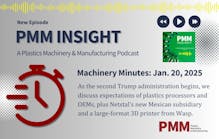By Karen Hanna
From monitoring machines to loading and unloading parts and removing support material, digitization and automation are coming to the world of 3D printing.
“As breakthroughs in automation, software and data are on the horizon, we are confident that the next generation of 3D printing will be that much more capable in providing users automized solutions,” said Francois Minec, global head of 3D polymers for HP’s Personalization and 3D Printing business, in an email.
Experts say the innovations are key to unlocking the potential of additive manufacturing (AM) and expanding AM technologies’ use in higher-volume applications.
Formlabs, Nexa3D, HP, Arburg and Aim3D are among OEMs touting their printers’ capabilities to work with less human intervention, thanks to advances in process control and auxiliary automation equipment. As 3D printing expert Brent Stucker, who’s worked for a number of OEMs over the last three decades, explained, there’s “a lot of interesting innovation going on in that post-processing, and a lot of that is to automate it, so you don’t need a person to do all the steps.”
Playing equally important roles in automating the whole process — including post-processing operations — are advances in software and hardware.
“We have the need to [integrate] additive manufacturing systems directly in other production lines to scale into series with more than 30,000 parts. As this is quite complex regarding not only the process stability but also the software and hardware interaction with other machines and processes, these steps will take time for both the AM OEMs and their customers,” said Aim3D Managing Director and Founder Vincent Morrison.
Integrated technologies
Set it-and-forget-it functionality is an important aspiration for both 3D printer users and makers hoping to break through to full-scale production. Formlabs’ Automation Ecosystem, a suite of three products designed to enable manufacturers to easily scale their 3D printer fleets to meet larger-volume needs, is among the newest 3D printing technologies boasting an array of features to automate the entire process. Other systems cited by representatives of OEMs include Arburg's Freeformer 750-3X and Nexa3D’s Xip Pro printer.
“Users are seeking increased production without added costs or labor needs,” said Derek Vilim, hardware product manager for Formlabs, whose 3D printers have made over 100 million parts. “Traditionally, 3D printing production has been limited by operator intervention, requiring users to remove complete printed parts, change resin cartridges and set new printing jobs manually.”
But Vilim and other OEM representatives say their companies are getting closer, with systems that integrate a variety of technologies and advanced controls.
Available within about the past year, “Formlabs’ Automation Ecosystem enables continuous production without requiring an onsite presence, allowing print jobs to continue during off hours,” Vilim said. The entire package includes Fleet Control software for fleet and workflow optimization; Form Auto, which automatically removes finished parts and initiates print jobs without operator intervention; and the High Volume Resin System, for creating a seamless resin supply that reduces packaging.
Taken together, the portfolio is “a step toward achieving greater 3D printing automation,” Vilim said.
In discussing his company’s newest AM machine, Victor Roman, managing director of Arburgadditive, also stressed integration.
“The Freeformer 750-3X can be IT networked via an IIoT gateway for a variety of purposes, such as integrating into the arburgXworld customer portal — the world of digital Arburg products and services — or enabling remote access,” he said. “An optional robotic interface allows additive manufacturing to be automated, and the Freeformer to be integrated into IT-networked production lines.”
Like the Automation Ecosystem and Freeformer 750-3X, the Xip Pro takes aim at processing bigger volumes.
Rather than constantly churning out parts, as injection molding machines (IMMs) do, the Xip Pro can run jobs stacked and programmed to start up seamlessly from one batch to the next, said Michael Currie, Nexa3D’s chief product officer.
“You can use automation to turn the machine over when you’re not there and get high utilization rates on the machine. I think that’s where we’re seeing it, just being able to be more available because you’re able to clear the machine without any human intervention,” Currie said.
Expanded oversight
Considering part build time, Aim3D’s Morrison said, process monitoring takes on extra significance.
“Conventional strategies, such as in-process part testing with laser sensors, are far too slow for the dynamics of the build process and do not improve their cost-effectiveness,” he said. “As a result, machine and plant suppliers need to change the way they view process control."
Watching over the fleet is software that is making strides toward hands-off production. OEMs pursuing process efficiency through software and process control innovations include Arburg and Nexa3D.
For Arburg, the mission of providing ease of use starts with the controller — the Gesticas used with its Freeformer AM machines are the same as the controllers for its IMMs. And, Roman said, they have been optimized for process stability, part quality and build time.
“The result is significantly reduced costs per component,” he said.
According to Roman, the Freeformer’s ProcessLog customer portal app provides graphics about a wide range of process and build job data, which, he said, “ensures transparency, high part quality and can significantly reduce rejects and error rates.”
Software is important to Nexa3D, too.
In a webinar touting the Xip Pro, Lewis Simms, the head of industrial product marketing for Nexa3D, discussed the benefits of using NexaX software, designed to make scaling from prototyping to full-scale production easy.
“This is our print-preparation software,” he said. “It has a few features to it that allows you to get your parts ready for the printer, and also has a fleet-management component where, if you have multiple printers in your fleet, you can manage prints and look at statuses across all of them.”
According to the company’s NexaX webpage, it enables “process stability, production scaling, consistent product quality, higher yields and unmatched mechanical performance.”
Auxiliary equipment steps up
Companies also are focusing on the hardware surrounding 3D printers.
Target applications include part loading and unloading, as well as other post-processing tasks. In addition to creating their own equipment, OEMs are examininghow their 3D printers can more seamlessly integrate with auxiliaries from other companies.
“It’s the time between the jobs, the setup time, as well as the post-processing,” said Fabian Krauss, head of polymer systems for EOS.
According to consultant Stucker, there’s a “pretty robust set of companies out there offering different types of post-processing solutions.”
But equipment still needs to improve, Simms said.
“You have people who build really giant printers, and then their post-processing units are like this big,” he said, gesturing during a video meeting to indicate a much smaller machine. “You can put like a couple of parts in there. It’s cute, but it's not really functional.”
Optimizing uptime and eliminating choke points are critical issues for 3D printer users, observed Morrison of Aim3D, which has touted its Material Extrusion (MEX) system.
The company’s process allows inline drying and feeding of material — similar to the process familiar among IMM users.
“Loading and unloading parts is the one and main topic for MEX Systems. This comes even more into focus if you work with high-performance or high-temperature materials, as these may need 1-2 hours of controlled cool-down,” he said. “If this is not automated you ‘lose’ machine time in which you otherwise could already build new parts.”
As an example of the evolution of auxiliary equipment, Phil DeSimone, a member of the CEO’s office and co-founder at Carbon, pointed to his company’s Smart Part Washer (SPW) system, which has been available for several years.
“Automation plays a big role in 3D printing, and Carbon’s use of automation has been shown to help customers increase production efficiency, consistency and quality,” he said.
Living large (scale)
For users looking for more flexibility to run large volumes of parts, the potential to scale up 3D printing could be tantalizing — but the technologies around it are critical.
“The rate of adoption is defined by cost. And can you scale one printer? OK. Five printers? Still easy. 50 printers?” EOS’ Krauss asked rhetorically. “How was that automated? How do you transfer the powder? How do you hook that into an MES system? How can you roll that out throughout the world? That’s what’s going to define the next five years. Beyond that, you tell me.”
Aim3D’s Morrison predicted production that takes advantage of an “integrated, digital 3D process chain.”
That future is coming — with experts like Nexa3D’s Simms saying that AM technologies are getting closer to becoming tools like any other on the plant floor, that can be integrated easily with other machines for seamless production.
EOS' Krauss said that while the cost of the technologies has remained steady over about the past decade, productivity continues to climb. The company’s P 500 printer is designed for automation and integration with other systems.
“The latest machines have that fully automated: An exchangeable frame goes out and a new, empty one goes in, and the machine starts again ... The most-valuable, the most-expensive component shall run 24/7/365," Krauss said.
Unpacking, depowdering and blasting steps are automated, and lights-out production is possible.
“You can run a full week with no human interaction," Krauss said.
Contact:
3DX Consulting LLC, Park City, Utah, 435-363-5197, [email protected]
Aim3D, Rostock, Germany, 49-381-367-66090, www.aim3d.de
Arburg Inc., Rocky Hill, Conn., 860-667-6500, www.arburg.com
Carbon Inc., Redwood City, Calif., 650-285-6307, www.carbon3d.com
EOS, Pflugerville, Texas, 512-388-7916; Novi, Mich., 248-306-0143, www.eos.info/en
Formlabs Inc., Somerville, Mass., 617-702-8476, www.formlabs.com
Nexa3D, Ventura, Calif., 800-797-0633, www.nexa3d.com
Karen Hanna | Senior Staff Reporter
Senior Staff Reporter Karen Hanna covers injection molding, molds and tooling, processors, workforce and other topics, and writes features including In Other Words and Problem Solved for Plastics Machinery & Manufacturing, Plastics Recycling and The Journal of Blow Molding. She has more than 15 years of experience in daily and magazine journalism.










